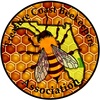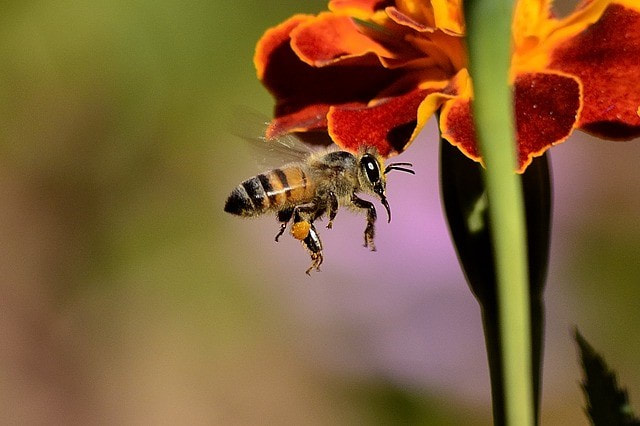As the weather begins to cool and the leaves start to burn with color, it’s time to think about making some changes to your garden. Not only will you be able to fill the space with more seasonally appropriate flowers and shrubs, you’ll be helping the bees find food and shelter.
Bees are incredibly important to our ecosystem; in fact, about ⅓ of all the foods we eat are dependent upon these tiny creatures to flourish. Pollination and cross-pollination can be artificially produced, but it’s a difficult, labor-intensive process, so keeping your local bees healthy and happy is imperative since their population is in danger due to pesticides and loss of habitat.
Do a little research to find out the best types of flowers to plant for fall in your area, and which ones will provide plenty of food for bees as the weather turns cooler and it becomes harder to find nectar. It’s also a good idea to think about changing up your landscaping, especially if it includes a lot of mulched areas, since bees often go underground to nest and need open areas to do it in.
Here are some of the best tips on how to get started.
Do some homework
Before you get started, you’ll need to do a little research on which plants are native to your region. Bees often adapt to local flowers and love the nectar they provide, so check to see which ones grow naturally where you live. Plant these in clusters, as bees usually like to feed in groups of flowers in order to have a big selection to choose from, and look for non-hybrid flowers. Hybrids are great for avid gardeners who want disease resistance and bigger, better blooms, but they don’t offer much in the way of food for the bees. Some great fall choices are purple aster, goldenrod, sunflowers, hydrangeas, pagoda ninewood, and ninebarks. You can go here for more great ideas.
Think about the type of plant you want
Flat-headed flowers make it easier for bees to access pollen, as they provide a sturdy place to stand and rest, so think about how to make use of these in bigger numbers than double-headed flowers. While these are beautiful blooms, they can make things more difficult for the bees.
Make it safe
Bees have many challenges to overcome, so give them a safe space in which to live, eat, and thrive. Never use pesticides on your plants; if you have a bug problem, consider using a natural, organic alternative. It’s also a good idea to set out a small bowl of water with protruding stones so your local bees can stop and get a drink without danger of falling in and drowning. Bees get thirsty, too!
Give them a home
Different types of bees enjoy different kinds of homes; some nest underground and need uncultivated soil to burrow in, while others prefer shrubs or blocks of wood. Do a little research on what types of bees live in your area and give them a safe place to rest and build a nest. For some great tips on fall landscaping, check out HomeAdvisor.com.
Give them shelter
Consider planting some shrubs if you don’t already have them; these will give bees a safe place to rest and protect them from the strong winds that autumn often brings.
Talk to your neighbors, friends, and family about how they can do their part for the bees, or think about starting a community garden so the bees in your area will have plenty of places to find food when summer starts to fade. Get the kids involved and make fall gardening a community effort.
Bees are incredibly important to our ecosystem; in fact, about ⅓ of all the foods we eat are dependent upon these tiny creatures to flourish. Pollination and cross-pollination can be artificially produced, but it’s a difficult, labor-intensive process, so keeping your local bees healthy and happy is imperative since their population is in danger due to pesticides and loss of habitat.
Do a little research to find out the best types of flowers to plant for fall in your area, and which ones will provide plenty of food for bees as the weather turns cooler and it becomes harder to find nectar. It’s also a good idea to think about changing up your landscaping, especially if it includes a lot of mulched areas, since bees often go underground to nest and need open areas to do it in.
Here are some of the best tips on how to get started.
Do some homework
Before you get started, you’ll need to do a little research on which plants are native to your region. Bees often adapt to local flowers and love the nectar they provide, so check to see which ones grow naturally where you live. Plant these in clusters, as bees usually like to feed in groups of flowers in order to have a big selection to choose from, and look for non-hybrid flowers. Hybrids are great for avid gardeners who want disease resistance and bigger, better blooms, but they don’t offer much in the way of food for the bees. Some great fall choices are purple aster, goldenrod, sunflowers, hydrangeas, pagoda ninewood, and ninebarks. You can go here for more great ideas.
Think about the type of plant you want
Flat-headed flowers make it easier for bees to access pollen, as they provide a sturdy place to stand and rest, so think about how to make use of these in bigger numbers than double-headed flowers. While these are beautiful blooms, they can make things more difficult for the bees.
Make it safe
Bees have many challenges to overcome, so give them a safe space in which to live, eat, and thrive. Never use pesticides on your plants; if you have a bug problem, consider using a natural, organic alternative. It’s also a good idea to set out a small bowl of water with protruding stones so your local bees can stop and get a drink without danger of falling in and drowning. Bees get thirsty, too!
Give them a home
Different types of bees enjoy different kinds of homes; some nest underground and need uncultivated soil to burrow in, while others prefer shrubs or blocks of wood. Do a little research on what types of bees live in your area and give them a safe place to rest and build a nest. For some great tips on fall landscaping, check out HomeAdvisor.com.
Give them shelter
Consider planting some shrubs if you don’t already have them; these will give bees a safe place to rest and protect them from the strong winds that autumn often brings.
Talk to your neighbors, friends, and family about how they can do their part for the bees, or think about starting a community garden so the bees in your area will have plenty of places to find food when summer starts to fade. Get the kids involved and make fall gardening a community effort.


 RSS Feed
RSS Feed
